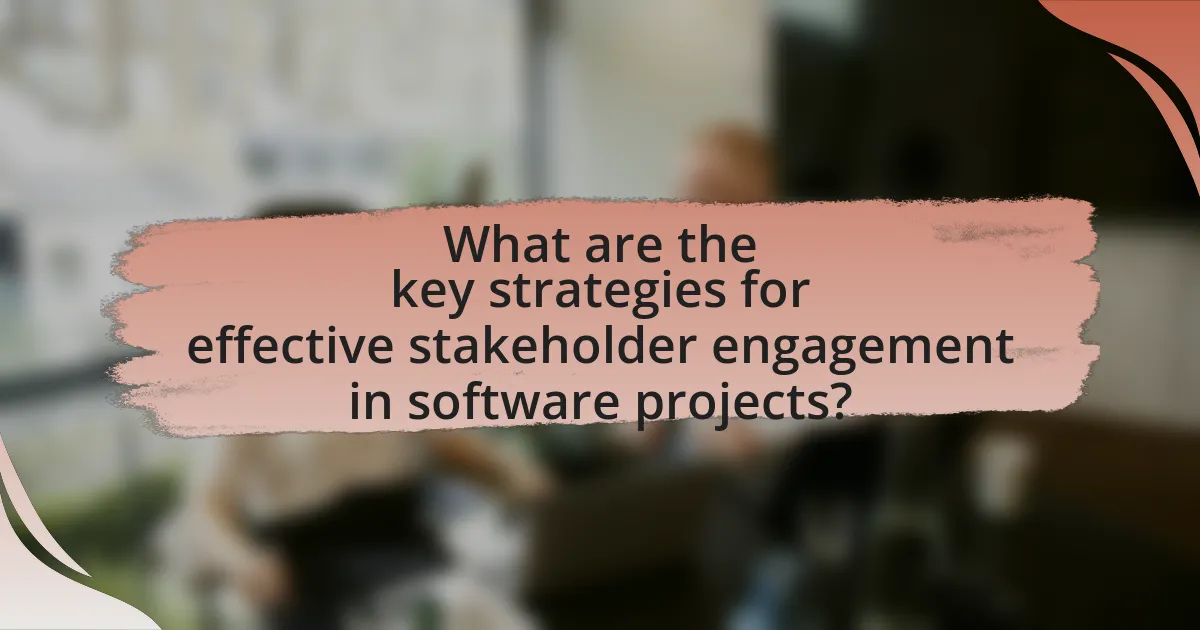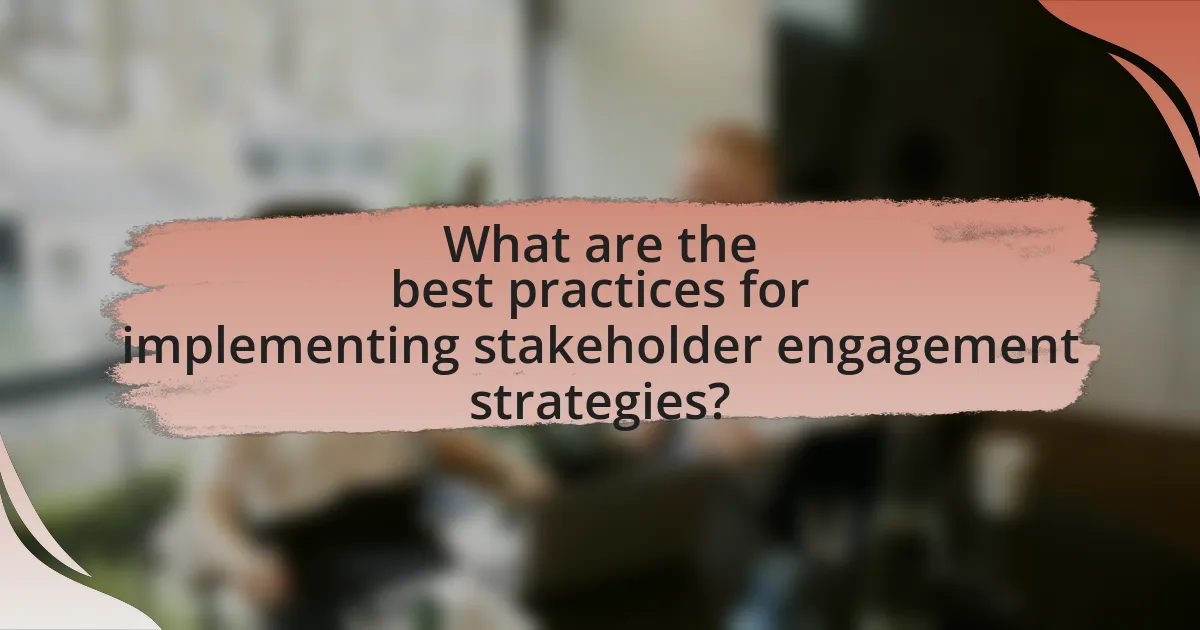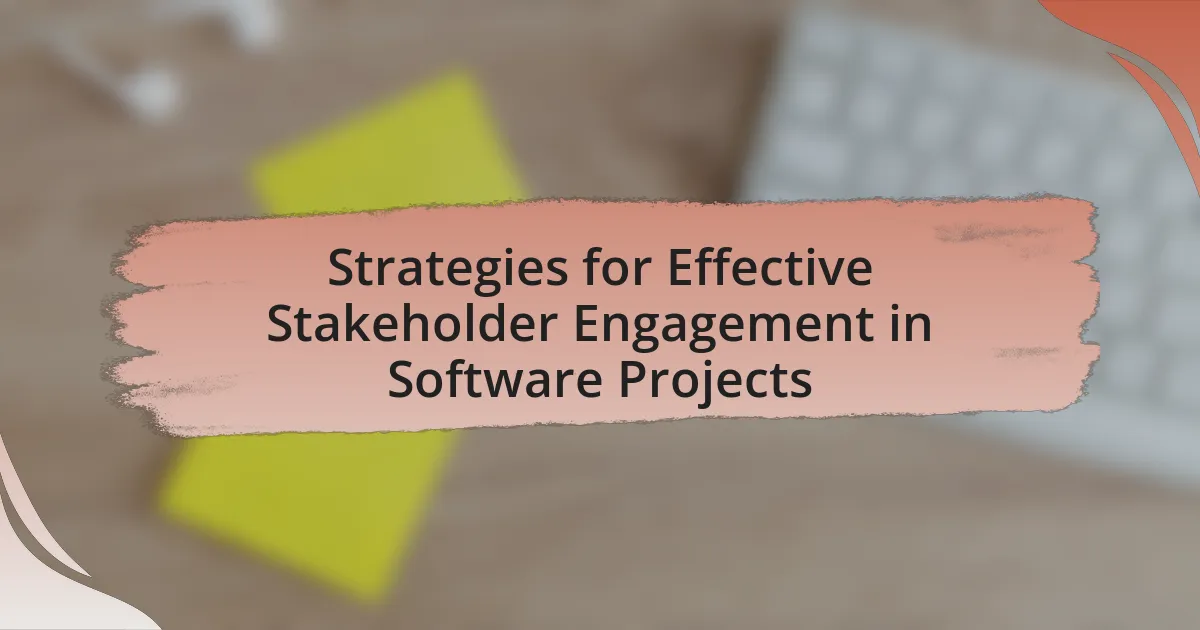The article focuses on strategies for effective stakeholder engagement in software projects, emphasizing the importance of clear communication, active listening, and regular feedback loops. It outlines how these strategies enhance project success by fostering collaboration and aligning stakeholder expectations with project objectives. Key factors influencing engagement, such as trust and involvement, are discussed, along with methods for identifying stakeholder needs and adapting engagement strategies to different project types. The article also addresses challenges in stakeholder engagement and provides practical tips for maintaining ongoing involvement and interest throughout the project lifecycle.

What are the key strategies for effective stakeholder engagement in software projects?
Key strategies for effective stakeholder engagement in software projects include clear communication, active listening, and regular feedback loops. Clear communication ensures that stakeholders understand project goals, timelines, and their roles, which is supported by studies showing that projects with defined communication plans have a 20% higher success rate. Active listening involves acknowledging stakeholder concerns and incorporating their input into project decisions, fostering a collaborative environment. Regular feedback loops, such as iterative reviews and updates, keep stakeholders informed and engaged, leading to improved satisfaction and project alignment. These strategies collectively enhance stakeholder relationships and project outcomes.
How do stakeholder engagement strategies impact project success?
Stakeholder engagement strategies significantly enhance project success by fostering collaboration, improving communication, and aligning project objectives with stakeholder expectations. Effective engagement leads to increased stakeholder satisfaction, which is crucial for project buy-in and support. Research indicates that projects with high stakeholder engagement are 20% more likely to succeed, as they benefit from diverse perspectives that can identify potential risks and opportunities early in the project lifecycle. Additionally, the Project Management Institute reports that effective stakeholder management can reduce project costs by up to 10% and improve project timelines by 15%, demonstrating the tangible benefits of strategic engagement.
What are the critical factors influencing stakeholder engagement?
The critical factors influencing stakeholder engagement include communication, trust, involvement, and clarity of purpose. Effective communication ensures that stakeholders are informed and their feedback is considered, which fosters trust. Trust is essential as it encourages stakeholders to share their insights and concerns openly. Involvement refers to actively engaging stakeholders in decision-making processes, which enhances their commitment to the project. Clarity of purpose ensures that all stakeholders understand the project’s goals and their roles, aligning their efforts towards common objectives. Research indicates that projects with high stakeholder engagement are 20% more likely to succeed, highlighting the importance of these factors in achieving effective stakeholder engagement in software projects.
How can stakeholder engagement strategies be tailored to different project types?
Stakeholder engagement strategies can be tailored to different project types by assessing the unique characteristics and requirements of each project. For instance, in agile software development projects, engagement strategies may focus on continuous feedback and collaboration through regular sprint reviews and daily stand-ups, allowing stakeholders to provide input frequently. Conversely, in traditional waterfall projects, engagement may be more structured, with defined phases for stakeholder input, such as requirements gathering and formal review stages.
Research indicates that adapting engagement methods based on project type enhances stakeholder satisfaction and project outcomes. A study by the Project Management Institute found that projects with tailored stakeholder engagement strategies are 20% more likely to meet their objectives. This evidence supports the notion that understanding the specific context and dynamics of each project type is crucial for effective stakeholder engagement.
Why is understanding stakeholder needs essential for engagement?
Understanding stakeholder needs is essential for engagement because it directly influences the success of software projects. When project teams accurately identify and address the specific requirements and expectations of stakeholders, they foster trust and collaboration, which are critical for project buy-in and support. Research indicates that projects with high stakeholder engagement are 20% more likely to succeed, as they align project outcomes with stakeholder interests, leading to increased satisfaction and reduced resistance.
What methods can be used to identify stakeholder needs?
To identify stakeholder needs, methods such as interviews, surveys, focus groups, and observation can be employed. Interviews allow for in-depth discussions with stakeholders to gather detailed insights about their expectations and requirements. Surveys can reach a larger audience quickly, providing quantitative data on stakeholder preferences. Focus groups facilitate interactive discussions among stakeholders, revealing diverse perspectives and collective needs. Observation enables project teams to understand stakeholder interactions and workflows, highlighting unspoken needs. These methods are widely recognized in project management literature as effective tools for gathering stakeholder input, ensuring that their needs are accurately captured and addressed in software projects.
How do stakeholder needs evolve throughout the project lifecycle?
Stakeholder needs evolve throughout the project lifecycle as they transition from initial expectations to more defined requirements and ultimately to satisfaction with project outcomes. In the initiation phase, stakeholders typically express broad goals and high-level expectations, which become more specific as the project progresses into planning and execution. During these phases, stakeholders may require regular updates and opportunities for feedback to ensure their needs are being met. As the project nears completion, their focus often shifts to evaluating deliverables against initial expectations and assessing overall project success. This evolution is supported by the Project Management Institute’s findings, which indicate that stakeholder engagement is critical at every stage to align project outcomes with stakeholder expectations, thereby enhancing satisfaction and project success rates.

What are the best practices for implementing stakeholder engagement strategies?
The best practices for implementing stakeholder engagement strategies include identifying stakeholders, establishing clear communication channels, and actively involving stakeholders in decision-making processes. Identifying stakeholders ensures that all relevant parties are recognized and their interests considered, which is crucial for project success. Establishing clear communication channels facilitates transparency and fosters trust, allowing stakeholders to express their concerns and feedback effectively. Actively involving stakeholders in decision-making processes enhances their commitment and ownership of the project, leading to better outcomes. Research by the Project Management Institute indicates that effective stakeholder engagement can improve project success rates by up to 20%.
How can communication be optimized for stakeholder engagement?
Communication can be optimized for stakeholder engagement by employing clear, consistent messaging tailored to the audience’s needs and preferences. This involves identifying key stakeholders, understanding their interests, and utilizing appropriate channels for communication, such as meetings, emails, or project management tools. Research indicates that effective communication strategies, including regular updates and feedback loops, enhance stakeholder satisfaction and project success rates. For instance, a study by the Project Management Institute found that projects with effective stakeholder engagement are 20% more likely to succeed.
What channels are most effective for stakeholder communication?
The most effective channels for stakeholder communication in software projects include email, meetings, project management tools, and instant messaging platforms. Email allows for detailed communication and documentation, while meetings facilitate real-time discussions and decision-making. Project management tools, such as Jira or Trello, provide transparency and track progress, enabling stakeholders to stay informed. Instant messaging platforms, like Slack, offer quick communication for urgent matters. Research indicates that using a combination of these channels enhances engagement and ensures that stakeholders receive timely and relevant information, ultimately leading to better project outcomes.
How can feedback mechanisms enhance stakeholder involvement?
Feedback mechanisms enhance stakeholder involvement by facilitating two-way communication, allowing stakeholders to express their opinions and concerns while also receiving updates on project progress. This interactive process fosters a sense of ownership and commitment among stakeholders, as they feel their input is valued and considered in decision-making. Research indicates that projects with robust feedback loops experience higher stakeholder satisfaction and engagement levels, as evidenced by a study published in the Journal of Project Management, which found that 75% of stakeholders reported increased involvement when feedback was actively solicited and acted upon.
What role does stakeholder analysis play in engagement strategies?
Stakeholder analysis is crucial in engagement strategies as it identifies and prioritizes the interests, influence, and needs of stakeholders involved in a project. By understanding these dynamics, project managers can tailor their communication and engagement efforts to address specific concerns and expectations, thereby enhancing collaboration and support. Research indicates that effective stakeholder engagement can lead to a 20% increase in project success rates, as highlighted in the Project Management Institute’s “Pulse of the Profession” report. This demonstrates that stakeholder analysis directly contributes to more effective engagement strategies, ultimately improving project outcomes.
How can stakeholder mapping improve engagement efforts?
Stakeholder mapping improves engagement efforts by identifying and prioritizing key stakeholders based on their influence and interest in a project. This strategic approach allows project managers to tailor communication and engagement strategies effectively, ensuring that the needs and concerns of each stakeholder group are addressed. Research indicates that projects with clear stakeholder mapping are 20% more likely to meet their objectives, as it facilitates targeted interactions and fosters stronger relationships. By understanding stakeholder dynamics, teams can allocate resources efficiently and enhance collaboration, ultimately leading to more successful project outcomes.
What tools are available for conducting stakeholder analysis?
Tools available for conducting stakeholder analysis include stakeholder mapping software, surveys, interviews, and analysis frameworks like the Power/Interest Grid and the Stakeholder Salience Model. Stakeholder mapping software, such as Miro or Lucidchart, visually represents stakeholder relationships and influences, facilitating better understanding. Surveys and interviews gather qualitative and quantitative data directly from stakeholders, providing insights into their needs and expectations. The Power/Interest Grid categorizes stakeholders based on their influence and interest, helping prioritize engagement efforts. The Stakeholder Salience Model assesses stakeholders based on their power, legitimacy, and urgency, guiding project managers in decision-making. These tools are widely recognized in project management literature for their effectiveness in enhancing stakeholder engagement strategies.

What challenges might arise in stakeholder engagement, and how can they be addressed?
Challenges in stakeholder engagement include communication barriers, conflicting interests, and lack of stakeholder involvement. Communication barriers can arise from differences in language, culture, or technical understanding, which can lead to misunderstandings. To address this, project managers should implement clear communication strategies, such as regular updates and using accessible language. Conflicting interests among stakeholders can hinder collaboration; this can be managed by facilitating open discussions to align goals and expectations. Lastly, lack of stakeholder involvement can result in disengagement; to counter this, project leaders should actively involve stakeholders in decision-making processes and seek their feedback consistently.
What common barriers hinder effective stakeholder engagement?
Common barriers that hinder effective stakeholder engagement include lack of communication, misaligned expectations, and insufficient involvement in decision-making processes. Lack of communication often leads to misunderstandings and a disconnect between stakeholders and project teams, which can result in unmet needs and dissatisfaction. Misaligned expectations occur when stakeholders have different visions or goals for the project, causing conflicts and delays. Insufficient involvement in decision-making processes can alienate stakeholders, making them feel undervalued and less likely to contribute positively. These barriers are frequently cited in project management literature, emphasizing the importance of clear communication, alignment of goals, and active participation to foster effective stakeholder engagement.
How can resistance from stakeholders be managed?
Resistance from stakeholders can be managed through effective communication and involvement in the decision-making process. Engaging stakeholders early and consistently allows them to voice concerns and contribute to solutions, fostering a sense of ownership. Research indicates that projects with high stakeholder involvement have a 20% higher success rate, as noted in the Project Management Institute’s “Pulse of the Profession” report. Additionally, addressing stakeholder feedback promptly and transparently can mitigate resistance, as stakeholders are more likely to support initiatives when they feel heard and valued.
What strategies can be employed to overcome communication gaps?
To overcome communication gaps, organizations can implement strategies such as establishing clear communication channels, utilizing regular updates, and fostering an inclusive environment. Clear communication channels, like dedicated project management tools, ensure that all stakeholders have access to the same information, reducing misunderstandings. Regular updates, such as weekly meetings or progress reports, keep everyone informed and engaged, which is crucial in software projects where requirements may evolve. Fostering an inclusive environment encourages open dialogue, allowing stakeholders to voice concerns and ask questions, thereby bridging gaps in understanding. These strategies are supported by research indicating that effective communication practices significantly enhance project outcomes and stakeholder satisfaction.
How can project managers ensure ongoing stakeholder engagement?
Project managers can ensure ongoing stakeholder engagement by implementing regular communication strategies and feedback mechanisms. Consistent updates through meetings, reports, and digital platforms keep stakeholders informed and involved in project developments. Research indicates that projects with frequent stakeholder communication have a 20% higher success rate, as stakeholders feel valued and their input is integrated into decision-making processes. Additionally, utilizing tools like surveys and feedback sessions allows project managers to gauge stakeholder satisfaction and adapt strategies accordingly, fostering a collaborative environment that enhances engagement.
What techniques can be used to maintain stakeholder interest throughout the project?
To maintain stakeholder interest throughout a project, regular communication and engagement techniques are essential. These techniques include scheduled updates, feedback sessions, and interactive workshops that keep stakeholders informed and involved in decision-making processes. For instance, studies show that projects with consistent communication strategies, such as bi-weekly progress reports, can increase stakeholder satisfaction by up to 30%. Additionally, utilizing tools like stakeholder mapping can help identify key interests and concerns, allowing project managers to tailor their engagement strategies effectively. This approach not only fosters transparency but also builds trust, ensuring stakeholders remain invested in the project’s success.
How can regular updates and transparency foster trust among stakeholders?
Regular updates and transparency foster trust among stakeholders by ensuring consistent communication and accountability. When stakeholders receive timely information about project progress, challenges, and changes, they feel informed and valued, which enhances their confidence in the project’s management. Research indicates that organizations that prioritize transparency experience higher levels of stakeholder satisfaction and engagement, as evidenced by a study published in the Journal of Business Ethics, which found that transparent communication significantly correlates with trust-building in collaborative environments. This consistent flow of information allows stakeholders to align their expectations with project realities, further solidifying their trust in the process and the team managing it.
What are the practical tips for enhancing stakeholder engagement in software projects?
To enhance stakeholder engagement in software projects, establish clear communication channels. Regular updates through meetings, emails, or project management tools ensure stakeholders are informed and involved. Additionally, actively solicit feedback during the project lifecycle, which fosters a sense of ownership and collaboration. Implementing stakeholder mapping helps identify key individuals and their interests, allowing for tailored engagement strategies. Research indicates that projects with high stakeholder involvement are 20% more likely to succeed, highlighting the importance of these practices.

Leave a Reply